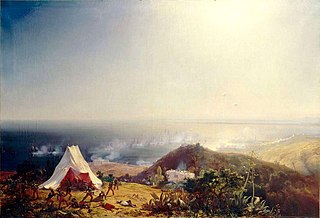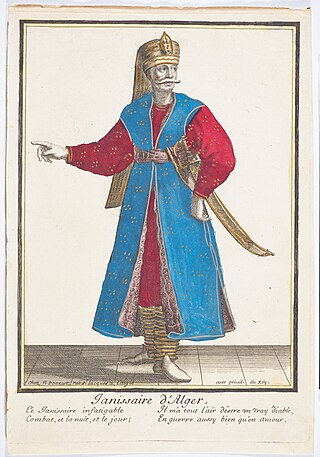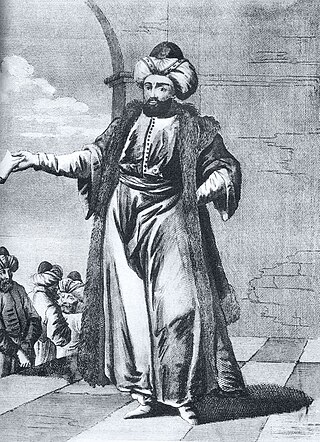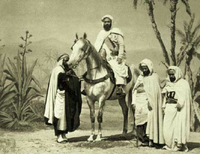
Dey, from the Turkish honorific title dayı, literally meaning uncle, was the title given to the rulers of the Regency of Algiers (Algeria), Tripoli, and Tunis under the Ottoman Empire from 1671 onwards. Twenty-nine deys held office from the establishment of the deylicate in Algeria until the French conquest in 1830.

Pastilla is a meat or seafood pie in Maghrebi cuisine made with warqa dough (ورقة), which is similar to filo. It is a specialty of Morocco, Algeria, and Tunisia, where its variation is known as malsouka. It has more recently been spread by emigrants to France, Israel, and North America.

Hussein Dey was the last Dey of the Deylik of Algiers.

The French conquest of Algeria took place between 1830 and 1903. In 1827, an argument between Hussein Dey, the ruler of the Regency of Algiers, and the French consul escalated into a blockade, following which the July Monarchy of France invaded and quickly seized Algiers in 1830, and seized other coastal communities. Amid internal political strife in France, decisions were repeatedly taken to retain control of the territory, and additional military forces were brought in over the following years to quell resistance in the interior of the country.

Ali V Ben Ahmed, nicknamed Ali Khodja, Ali-Meguer, or Ali Loco was a Kouloughli of partial Georgian (Mengrelian) and Native Algerian origins born in Algeria. He was the dey of the Deylik of Algiers from September 1817, just after the assassination of his predecessor Omar Agha the 8th. He remained so until his death in February 1818. His sobriquet Ali-Meguer may indicate his Mingrelian background.

Battle of Staoueli, was a battle between the Kingdom of France and the Regency of Algiers in western Algiers while France was trying to take control over the capital.
The First Expedition of Blida took place from 22 to 24 July 1830, during the French conquest of Algeria.
The first Médéa expedition, also known as the Atlas expedition of 1830 was a military expedition conducted by the Kingdom of France against the remnants of the Deylik of Algiers, the Beylik of Titteri and the local resistance led by Mohamed ben Zaamoum. It began on 17 November 1830 and ended eight in early December.

The bombardment of Algiers in 1683 was a French naval operation against the Regency of Algiers during the French-Algerian War 1681–88. It led to the rescue of more than 100 French prisoners, in some cases after decades of captivity, but the great majority of Christian captives in Algiers were not liberated.
The Battle of Chelif or Battle of Djidouia took place on 28 April 1701 on the banks of the Chelif River. It was fought between the armies of the Alaouite Sultan Ismail Ibn Sharif and those of the Regency of Algiers commanded by the Bey of Mascara, Mustapha Bouchelaghem. It took place in the context of an attempt by the Alaouites to conquer the west of the Regency of Algiers, coordinated with an offensive by Tunis on the east of the Regency of Algiers in 1700 and 1701.

The Algerian popular resistance against French invasion refers to resistance in Algeria against the French conquest, which began with the invasion of Algiers in 1830 and lasted until 1903.

The Odjak of Algiers was a unit of the Algerian army. It was a highly autonomous part of the Janissary Corps, acting completely independently from the rest of the corps, similar to the relationship between Algiers and the Sublime Porte. Led by an Agha, they also took part in the country's internal administration and politics, ruling the country for several years. They acted as a defense unit, a Praetorian Guard, and an instrument of repression until 1817.

The First Battle of Boudouaou in 25–26 May 1837, during the French conquest of Algeria, pitted the troupes coloniales under Colonel Maximilien Joseph Schauenburg against the troops of Kabylia of the Igawawen.
The Massacre of El Ouffia took place on 6 April 1832 during the French conquest of Algeria. It was a war crime committed against the tribe of El Ouffia near El Harrach by the Troupes Coloniales under Colonel Maximilien Joseph Schauenburg.

The First Battle of the Issers in May 1837, during the French conquest of Algeria, pitted the troupes coloniales under General Perrégaux and Colonel Schauenburg against the troops of Kabylia of the Igawawen.
The Shipwreck of Dellys took place in May 1830, during the French conquest of Algeria. It involved French troupes coloniales, under captains Félix-Ariel d'Assigny (1794-1846) and Armand Joseph Bruat (1796-1855), who were captured by the resistance fighters of the town of Dellys in Kabylia of the Igawawen.
Mohamed ben Zamoum was a Kabyle marabout who participated in the Algerian resistance against the French conquest of Algeria.
The Maghrebi war (1699–1702) was a conflict involving a Tunisian, Tripolitanian, and Moroccan coalition, and the Deylik of Algiers. It was an important milestone in the further weakening of the already fragile Ottoman grip over the Maghreb, as both sides utterly ignored the Ottoman sultan's pleas to sign a peace treaty. This war also led to the renewal of the Muradid infighting, which would later lead to the establishment of the Beylik of Tunis, and the Husainid dynasty in 1705.

The Beylik of Titteri,, was one of the three permanent Beyliks of the Regency of Algiers, the other two being the Western Beylik, and the Beylik of Constantine. It was established in 1546 and was ended during the French conquest of Algeria.

The Tunisian–Algerian War of 1807 was a conflict between the Beylik of Tunis and the Deylik of Algiers. The war led to the emancipation of Tunisia from any sort of Algerian influence, and the ending of the tribute paid by Tunisia to Algeria since 1756.




















